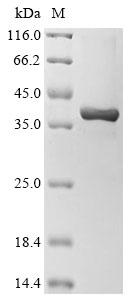Recombinant Mouse Non-receptor tyrosine-protein kinase TYK2 (Tyk2) is produced in an E. coli expression system, covering the 884-1174 amino acid region. This partial protein includes an N-terminal 10xHis-tag and a C-terminal Myc-tag for purification and detection purposes. SDS-PAGE analysis confirms the product shows purity greater than 85%, which appears suitable for various research applications.
TYK2 represents a key member of the Janus kinase (JAK) family. It plays an important role in signaling pathways for different cytokines and growth factors. The protein is involved in mediating immune responses and cellular communication, suggesting it may be valuable for understanding immune system mechanisms and signal transduction in research contexts.
Potential Applications
Note: The applications listed below are based on what we know about this protein's biological functions, published research, and experience from experts in the field. However, we haven't fully tested all of these applications ourselves yet. We'd recommend running some preliminary tests first to make sure they work for your specific research goals.
Based on the provided information, the recombinant mouse TYK2 kinase domain fragment is expressed in E. coli, a prokaryotic system that is generally unsuitable for producing functional eukaryotic kinase domains. TYK2 is a complex non-receptor tyrosine kinase that requires precise folding, proper activation loop conformation, and specific phosphorylation for its catalytic activity. The expressed fragment (884-1174aa) represents only the kinase domain with dual tags (N-terminal 10xHis and C-terminal Myc) and >85% purity. However, E. coli lacks the eukaryotic chaperones, phosphorylation machinery, and regulatory mechanisms necessary for proper kinase folding and activation. Kinase domains require precise conformational changes and often need trans-autophosphorylation or upstream kinase activation for functionality. Since activity is unverified, the protein cannot be assumed to be correctly folded or bioactive without experimental validation of its kinase activity and proper folding.
1. Antibody Development and Validation
The recombinant TYK2 kinase domain can serve as an effective immunogen for generating antibodies that recognize linear epitopes within the 884-1174aa region, even if the protein is misfolded. The dual tags facilitate purification and detection. However, antibodies may not recognize conformational or phosphorylation-dependent epitopes of native, properly folded, and activated TYK2 in mouse cells. Validation against endogenous TYK2 from mammalian systems is essential.
2. Tag-Assisted Protein Interaction Studies
This application is high-risk without proper folding validation. While the dual tags enable technical feasibility for pull-down assays, if the TYK2 kinase domain is misfolded (as likely in E. coli), it will not interact physiologically with true binding partners (e.g., cytokine receptors, STAT proteins, or substrates). Kinase domains require precise conformation for specific interactions. Identified interactions could be non-physiological artifacts. This application should not be pursued without confirmation of proper folding and kinase activity.
3. ELISA-Based Binding Assays
This application is problematic without activity verification. If the TYK2 kinase domain is misfolded, binding assays will not reflect biological specificity. Kinase-substrate interactions require proper active site conformation. This application requires prior demonstration of proper folding and validation with known binding partners or substrates.
4. Biochemical Characterization Studies
This application is well-suited for assessing the recombinant mouse TYK2 itself. Techniques like circular dichroism spectroscopy, size-exclusion chromatography, and thermal shift assays can evaluate the protein's folding state, oligomerization, and stability. These studies are valuable even if the protein is inactive, as they characterize the recombinant product and can inform about its suitability for other applications.
Final Recommendation & Action Plan
Given the high probability of misfolding in E. coli for this complex eukaryotic kinase domain, recommend first performing comprehensive validation: 1) Functional validation using kinase activity assays with known substrates (e.g., STAT proteins) and ATP; 2) Biophysical characterization (circular dichroism for secondary structure, analytical ultracentrifugation for oligomeric state) to assess folding quality; 3) Phosphorylation status analysis to check activation loop conformation. Antibody development can proceed immediately as the safest application. Avoid all functional studies (interactions, binding assays) until proper folding and kinase activity are confirmed. For reliable TYK2 research, obtain the kinase domain from mammalian or insect cell expression systems capable of proper folding and phosphorylation. Always include appropriate controls, such as known kinase substrates and active kinase standards, in experiments.






